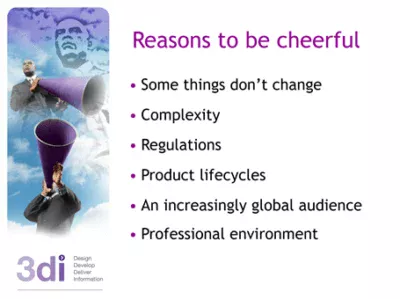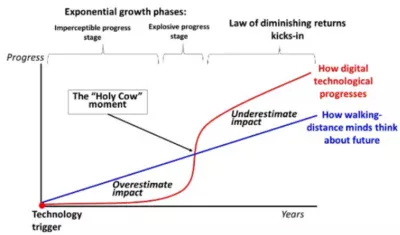This article was originally published in ISTC Communicator, Summer 2021
Predicting the future is easy. Getting it right is not. I’ve had fun working on this article, because a large part of the process has involved researching what some folks in our profession have predicted, or described as an emerging trend, over the years. The thread of this article will combine three things: my reflection on some of those predictions, what feels like relatively new approaches my colleagues and I at 3di are deploying with customers, and the context and insights provided by a book that I have recently read: The Globotics Upheaval by Richard Baldwin, published in 2019.
Reasons to be cheerful
20 years ago, there was an emerging technology going by the name of DITA (Darwin Information Typing Architecture). Developed by a team at IBM in the late 1990s to leverage the features of XML and create a common schema for sharing technical product content, other global technology companies joined the initiative and by 2005 DITA had definitely emerged. In the summer 2005 Communicator, IBM’s Ian Larner’s article Introducing DITA described how “Outside IBM, there is growing take-up of DITA for information development by companies and individuals.” Since then it sometimes feels like DITA has somehow both dominated and still been emerging at the same time. It’s certainly possible for a technical author to have avoided it completely, even one who has spent their entire career documenting software (and I know several).
At around the same time, a new help authoring tool was emerging. Madcap Software had set up in the early 2000s, and their new tool Flare had just launched in 2006. The team at Cherryleaf had reviewed the new tool and Carol Johnston summarised in her summer 2006 Communicator article “Flare’s future looks bright but it is not a tool for authors unwilling to get their hands dirty with a bit of XML and CSS coding knowledge.” Given Madcap Flare’s growing dominance of the help authoring tool market since then, Cherryleaf had it about right – including about the willingness to hack every now and then.
So, tools, technologies, and related standards have often been the headline-grabbing subjects of predictions for the future drivers or influences on technical communication, and your career would have likely thrived if you had taken up Ian’s or Carol’s implicit suggestions and invested your time in becoming an expert in deploying DITA or Flare 15+ years ago.
From my perspective though, it’s not been tools, technologies, or standards that have sparked my interest in trying to imagine what the future holds for our profession. I’ve spent over 25 years selling technical communication to organisations with complex products, so my focus on the future has tended to be driven by understanding what is changing for those organisations and the people in them who need our expertise. If we can understand that, then we can make sure we are ready to provide what they will need.

So, at around the same time DITA and Flare were emerging and starting to drive change in our industry, I was thinking about and sharing my Reasons to be cheerful at the ISTC Conference in October 2007. The theme of that presentation had been inspired by the glum and pessimistic rhetoric that seemed to persist in the profession in the UK. Since then of course I have realised it’s apparently a perennial existential crisis, which I frankly no longer have the patience for. The presentation was a manifesto, asserting that there were several key trends and factors that were going to benefit our profession broadly, but that individually, we would need to recognise the link between those trends and the value they represented for our employers or customers. I stand by my reasons to be cheerful, and still observe them all continuing to have positive influences on the opportunities for technical communicators 14 years later.
Ever-closer integration
If there is one trend I would bet on, it is that it will become increasingly important for us to make sure the content we create feels like part of the product. Just to be clear, this is not a new trend. I would argue the introduction of Flare and DITA 15+ years ago was part of the start of breaking down the barriers between products and the information about them. However, in the spirit of illustrating my first listed reason to be cheerful “Some things don’t change”, we still get technology manufacturers contacting 3di, asking for a ‘manual’. As we discuss the possibilities, they are genuinely amazed at the idea that their browser-based HMI (Human Machine Interface) could have an embedded set of HTML content that is exactly the same as the PDF manual they are wedded to. This trend that started for our profession over 20 years ago is still an innovation to many of the organisations we serve. For some of you, this may be depressing, but it fills me with hope. If that rocks their world, then imagine what we could do for them if we really get going!
If there is one trend I would bet on, it is that it will become increasingly important for us to make sure the content we create feels like part of the product
At the other end of the spectrum, 3di has customers who drive us and inspire us to design and deploy completely new ways of delivering technical communication. And it is ever-closer integration that underpins these relationships. This is the world’s of embedded UA, docs-as-code, documentation within DevOps, and Continuous Deployment.
Want to find out more?
With our customers interested in a developer audience – typically SaaS companies, trying to make their APIs as easy to use as possible – we might be combining writing in Markdown, with code examples written by the developers and pulled into a GitLab repository automatically. The API reference may be published as Open API, taken from the auto-build and incorporated into the rest of the content.
Although the tools and technologies seem to dominate the approach, the driver for the customer (that is, the trend that provides 3di with the opportunity to deliver our expertise) is the expectation that surely their world of CI/CD could be replicated and supported by the documentation. The same principle applies in the world of embedded UA – software companies increasingly expect the join between the UI and the help about the UI to be seamless, so we need to make sure we can deploy tools features such as micro-content, simplified user interfaces (SUIs), and design content models that support chatbots and personalised help content.
The “Holy cow” moment in The Globotics Upheaval
Richard Baldwin’s book The Globotics Upheaval makes the case that “we now stand on the edge of a new era that will bring change to our world on a par with the Industrial Revolution. Automation, artificial intelligence (AI) and robotics are changing our lives quickly – but digital disruption goes much further then we realise.” He coins the term Globotics to convey the current iteration of the two forces that have shaped relatively rapid societal changes over the last 300 years: Globalization and Automation (or robotics). He argues that “the inhuman speed of this transformation threatens to overwhelm our capacity to adapt. When technology enables people from around the world to be a virtual presence in any given office, Globotics will disrupt the lives of millions of skilled workers much faster than automation, industrialisation, and globalisation disrupted lives in previous centuries.
Bearing in mind The Globotics Upheaval was published in 2019, the pandemic has provided no shortage of evidence of some of the changes he was predicting.
He’s not the only one worried about our ability to adapt. In today’s Guardian, Daniel Kahneman is interviewed about his just-published book Noise: A flaw in Human Judgement. Kahneman is the Nobel prize-winning economist whose first book Thinking, Fast and Slow, set out his revolutionary ideas about human error and bias. One of his observations in the interview today was “Exponential phenomena are almost impossible for us to grasp. We are very experienced in a more or less linear world, and if things are accelerating, they’re usually accelerating within reason. Exponential change [as with the spread of the virus] is really something else. We’re not equipped for it. It takes a long time to educate intuition.”
So, back to Richard Baldwin, he presents a useful illustration of why it is so hard to get predictions about the future impacts of digital technology right. He calls it the Holy-Cow Diagram.

The illustration includes a reference to futurist Roy Amara’s ‘law’ that we tend to overestimate the effect of a technology in the short-term and underestimate the effect in the long run. Baldwin’s book makes predictions about the future of society and provides clues and tips about how to short-circuit our too-slow tendency to understand what’s going on so that we can prepare and be ready to adapt.
What has this to do with emerging trends in technical communication?
Well, firstly, reading the book over the last few months has coincided with 3di experiencing first-hand several of the trends Baldwin has observed and predicts. For example:
- A significant increase in interest from robotics manufacturers.
- A similar increase in interest from software platform developers that are enabling automation of activities that would currently be manual.
- We are deploying ourselves tools combinations and workflows that are replacing manual activities with automation.
- New enquiries from customers in far-flung countries seeing geography and time-zone differences as pretty low barriers to overcome to gain access to the (possibly cheaper) skills they need.
- By extension, we are finding it easier (and necessary) to find and deploy freelance technical writers from around the world to work as part of our teams, just as we have always done so for translators.
Secondly, I am constantly reminded about the inherently and uniquely human qualities that are likely to insulate technical communication (broadly) against the upheavals that await us all. Baldwin shares extensively the 2017 McKinsey Global Institute research that predicts AI’s ability to replicate many of the ‘communication’ workplace skills that our profession deploys is still decades away.
So that’s the Artificial Intelligence (AI) taken care of, but what about Remote Intelligence (RI)? Well, there the challenge for many of us will be far more urgent. The pandemic has accelerated the preparedness of organisations worldwide to not require their office staff to work at the office, and the digital technology that Baldwin describes makes it easier for resources to be based anywhere in the world. 3di has benefitted in the short-term by being able to provide remote services, but in the medium and longer term, there will almost certainly be a drift away from technical communication resources sitting in relatively expensive countries to those sitting in relatively cheap ones. That trend will affect us all.
“If we can keep focussed on what matters to the organisations we serve, I am fundamentally hopeful about our collective prospects.”
On balance, there are still reasons to be cheerful
Alongside the Globotics Upheaval that Richard Baldwin describes, there will still be lots of technology companies that need clear communication about complex products, lots of new regulations, and increasing expectations of all-manner of products to be easier to install, use, maintain and service. We will no doubt have new tools to use and the proportion of manual to automated tasks will continue to shift, and the global marketplace will feel increasingly competitive…but if we can keep focused on what matters to the organisations we serve, I am fundamentally hopeful about our collective prospects.
References
Adams T (2021) ‘Daniel Kahneman: ‘Clearly AI is going to win. How people are going to adjust is a fascinating problem’ The Guardian. 16 May 2021. (accessed 17 May 2021).
Amara’s law, www.pcmag.com, (accessed 17 May 2021).
Baldwin R (2018) ‘Artificial intelligence for international economists (by an international economist): Part 1 of 5’ VoxEU.org. 7 December 2018. (accessed 17 May 2021).
Baldwin R (2019) ‘The Globotics Upheaval: Globalisation, Robotics and the Future of Work’ W&N.
Johnston C (2006) ‘Review of MadCap Flare version 1.0.2’ Communicator, Summer 2006: page 22-24.
Kahneman D (2012) ‘Thinking, Fast and Slow’, Penguin.
Kahneman D, Sibony O and Sunstein C R (2021) ‘Noise: A Flaw in Human Judgement’, Williams Collins.
Larner I (2005) ‘Darwin Information Typing Architecture’ Communicator, Summer 2005: 29-31.
Wisniewski J (2020) ‘Markdown for documentation: 6 pros and 5 things to consider’ (accessed 19 May 2021).
.
Related articles

Capturing information and crafting content
Read our guide on capturing information and crafting content

How to ensure your technical documentation works
One of our team explains how you can ensure your documentation works

